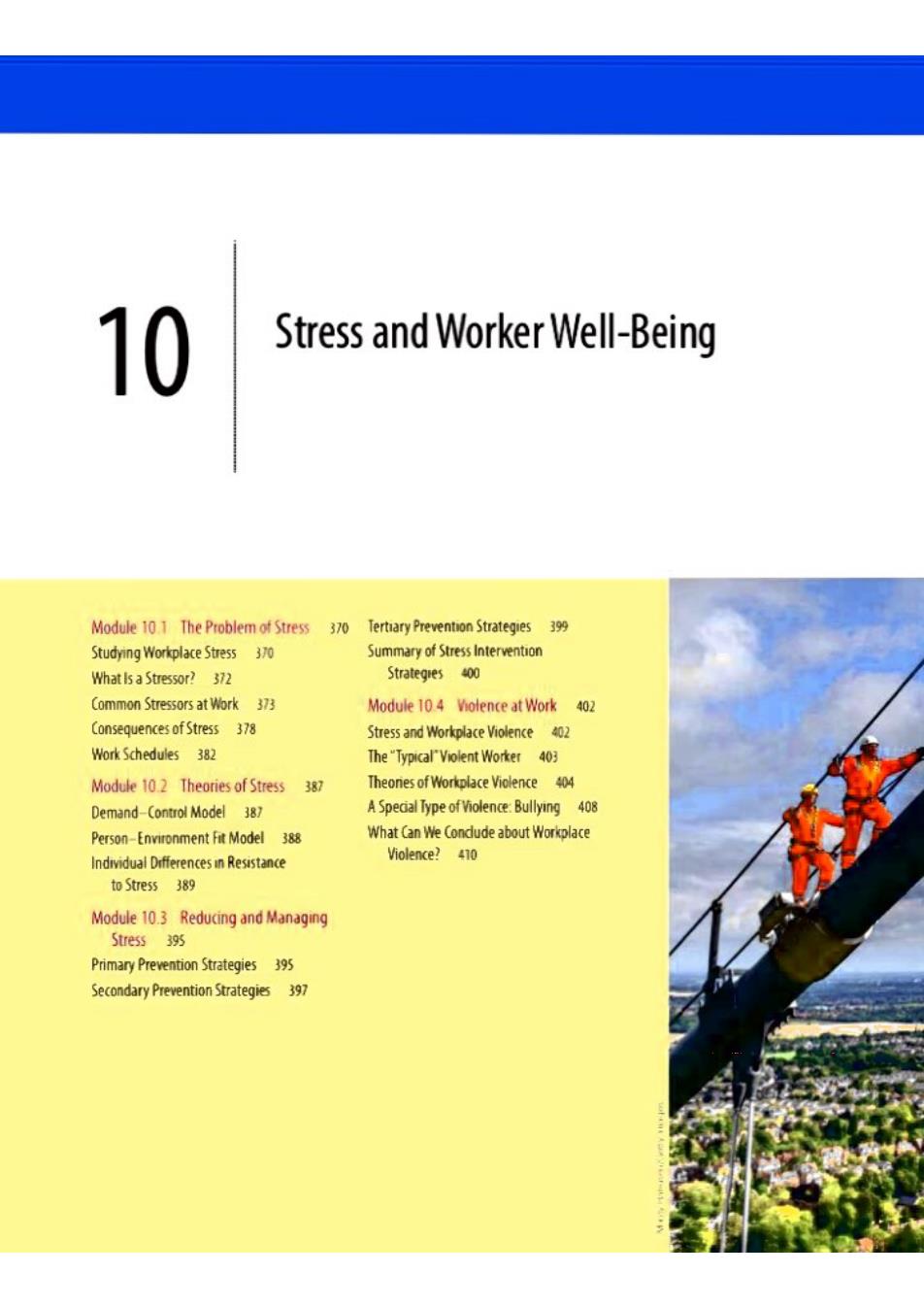
10 Stress and Worker Well-Being Module 10 1 The Problem of Stress 370 Tertiary Prevention Strategies 399 Studying Workplace Stress 370 Summary of Stress Intervention What Is a Stressor?372 Strategies 400 Common Stressors at Work 373 Module 104 Violence at Work 402 Consequences of Stress 378 Stress and Workplace Violence 402 Work Schedules 382 The"Typical'Violent Worker 403 Module 102 Theories of Stress 387 Theones of Workplace Violence 404 Demand-Control Model 387 A Specal Type ofViolence:Bullying 408 Person-Environment Fit Model 388 What Can We Condude about Workplace Individual Drfferencesn Resistance Violence?410 to Stress 389 Module 10.3 Reducing and Managing Stress 395 Primary Prevention Strategies 395 Secondary Prevention Strategies 397
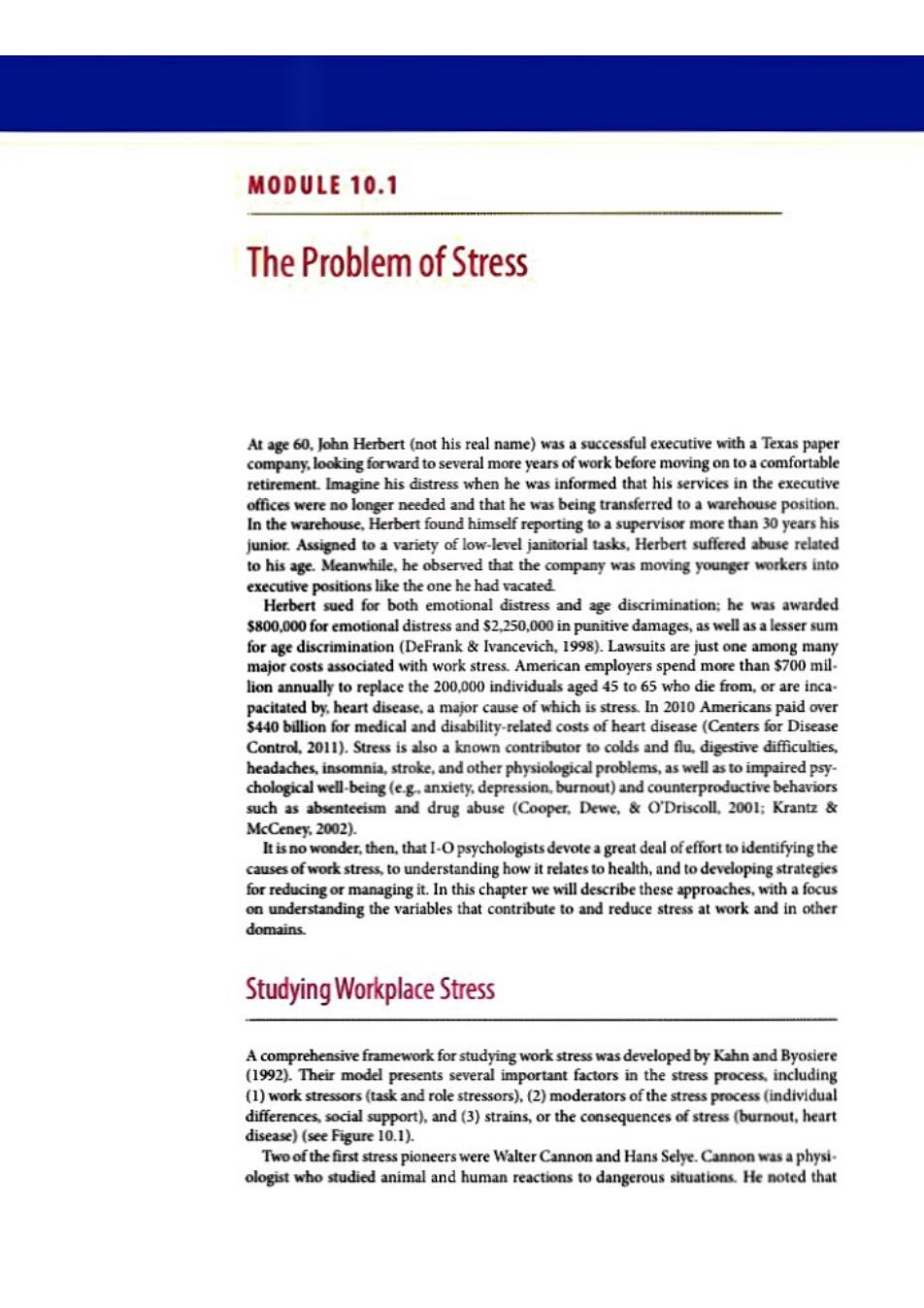
MODULE 10.1 The Problem of Stress At age 60.John Herbert (not his real name)was a successful executive with a Texas paper company.looking forward to several more years of work before moving on to a comfortable retirement.Imagine his distress when he was informed that his services in the executive offices were no longer needed and that he was being transferred to a warehouse position. In the warehouse,Herbert found himself reporting to a supervisor more than 30 years his junior.Assigned to a variety of low-level janitorial tasks.Herbert suffered abuse related to his age.Meanwhile,he observed that the company was moving younger workers into executive positions like the one he had vacated Herbert sued for both emotional distress and age discrimination:he was awarded $800,000 for emotional distress and $2,250,000 in punitive damages,as well as a lesser sum for age discrimination(DeFrank Ivancevich,1998).Lawsuits are just one among many major costs associated with work stress.American employers spend more than $700 mil. lion annually to replace the 200,000 individuals aged 45 to 65 who die from,or are inca- pacitated by,heart disease.a major cause of which is stress.In 2010 Americans paid over $440 billion for medical and disability-related costs of heart disease(Centers for Disease Control,2011).Stress is also a known contributor to colds and flu,digestive difficulties, headaches,insomnia,stroke,and other physiological problems,as well as to impaired psy- chological well-being(e.g.anxiety,depression.burnout)and counterproductive behaviors such as absenteeism and drug abuse (Cooper,Dewe,O'Driscoll.2001;Krantz McCeney,2002). It is no wonder,then.that I-O psychologists devote a great deal of effort to identifying the causes of work stress,to understanding how it relates to health,and to developing strategies for reducing or managing it.In this chapter we will describe these approaches,with a focus on understanding the variables that contribute to and reduce stress at work and in other domains. Studying Workplace Stress A comprehensive framework for studying work stress was developed by Kahn and Byosiere (1992).Their model presents several important factors in the stress process.including (1)work stressors (task and role stressors).(2)moderators of the stress process (individual differences,social support),and (3)strains,or the consequences of stress (burnout,heart disease)(see Figure 10.1). Two of the first stress pioneers were Walter Cannon and Hans Selye.Cannon was a physi. ologist who studied animal and human reactions to dangerous situations.He noted that
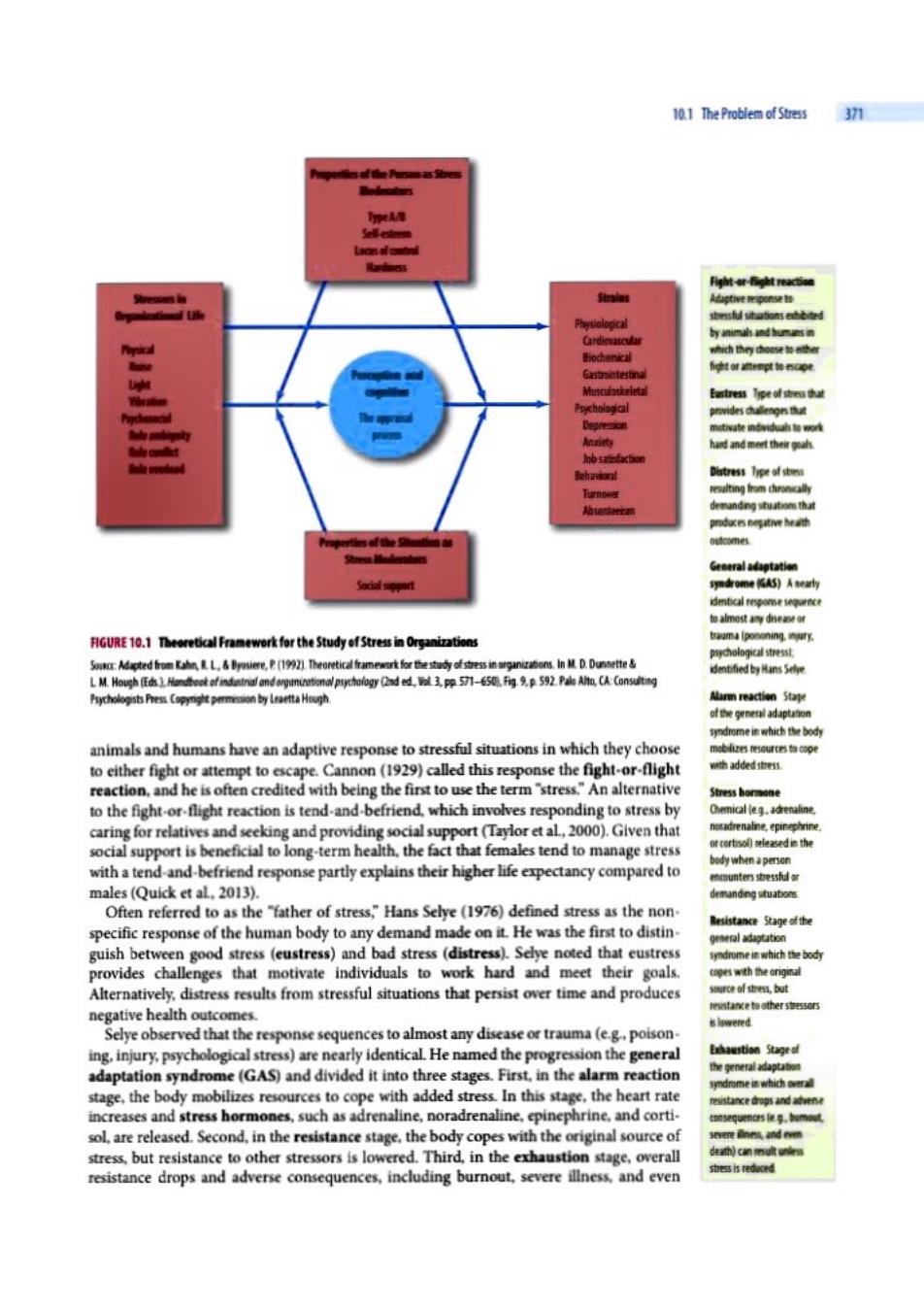
10.1 The Problem of Stress 3万 hh的的daee每e中g 三 h中傅tempt to mcape Fustress lpeol shess that prvides challenges thut mtivate nid每g nx的 hand and meet their oa lob sarsfaction Distress Type of ss resiting frem chroncally d年anding stuatioes th produces negative heath outcomes. General adagtation mdrome65A转y dmbcal repome sepuence omo银m diseae or FGURE 10.1 Theoretical Framework for the Study of Stress in Organizations truma (ponening.nury. ppchological stpessl oc:Adacted from【u点LL&rusiere.(1992).eoretical frameweri for the奇ct女ess in organizaons.h慧D.Dunsette& identified与4nmSe LM.Hough()findtnal adarganuntonalpychology (nd ed.Vol 3.pp 571-650 Figp 592.Pale Alo CAConwng ychologists Press Capymght permmion by Leaetta Hough 山m体action5求 of the genenl adaptaton drome in which制bod animals and humans have an adaptive response to stressful situations in which they choose meblizes tesources与coe to either fight or attempt to escape.Cannon (1929)called this response the fight-or-flight wth added stess. reaction,and he is often credited with being the first to use the term'stress."An alternative Stress hormone to the fight-or-flight reaction is tend-and-befriend.which involves responding to stress by Chemical le.g.adrenaline caring for relatives and seeking and providing social support (Taylor et al,2000).Given that social support is beneficial to long-term health.the fact that females tend to manage stress 前crtso)leedin the body when a persen with a tend-and-befriend response partly explains their higher life expectancy compared to encounters stresstulor males(Quick et al,2013). demanding stuaboes Often referred to as the "father of stress,"Hans Selye (1976)defined stress as the non. Resistance Stage ofthe specific response of the human body to any demand made on it.He was the first to distin. gmneral ac山ptation guish between good stress (eustress)and bad stress(distress).Selye noted that eustress sdmme in which the boc寸 provides challenges that motivate individuals to work hard and meet their goals. cpes with the original Alternatively,distress results from stressful situations that persist over time and produces source of stress,but negative health outcomes. feKe与other stes5a5 sawered Selye observed that the response sequences to almost any disease or trauma (e.g.poison. ing.injury,psychological stress)are nearly identical He named the progression the general Ehaustion Stage of adaptation syndrome(GAS)and divided it into three stages.First.in the alarm reaction the general adaptaton sydrome in which overall stage,the body mobilizes resources to cope with added stress.In this stage,the heart rate et家edrups and advene increases and stress hormones,such as adrenaline,noradrenaline,epinephrine,and corti. csequenors fe.g.bumout sol,are released.Second,in the resistance stage,the body copes with the original source of severe iness and even stress,but resistance to other stressors is lowered.Third,in the exhaustion stage,overall t制c输w哺n相 sts书edad resistance drops and adverse consequences,including burnout,severe illness,and even
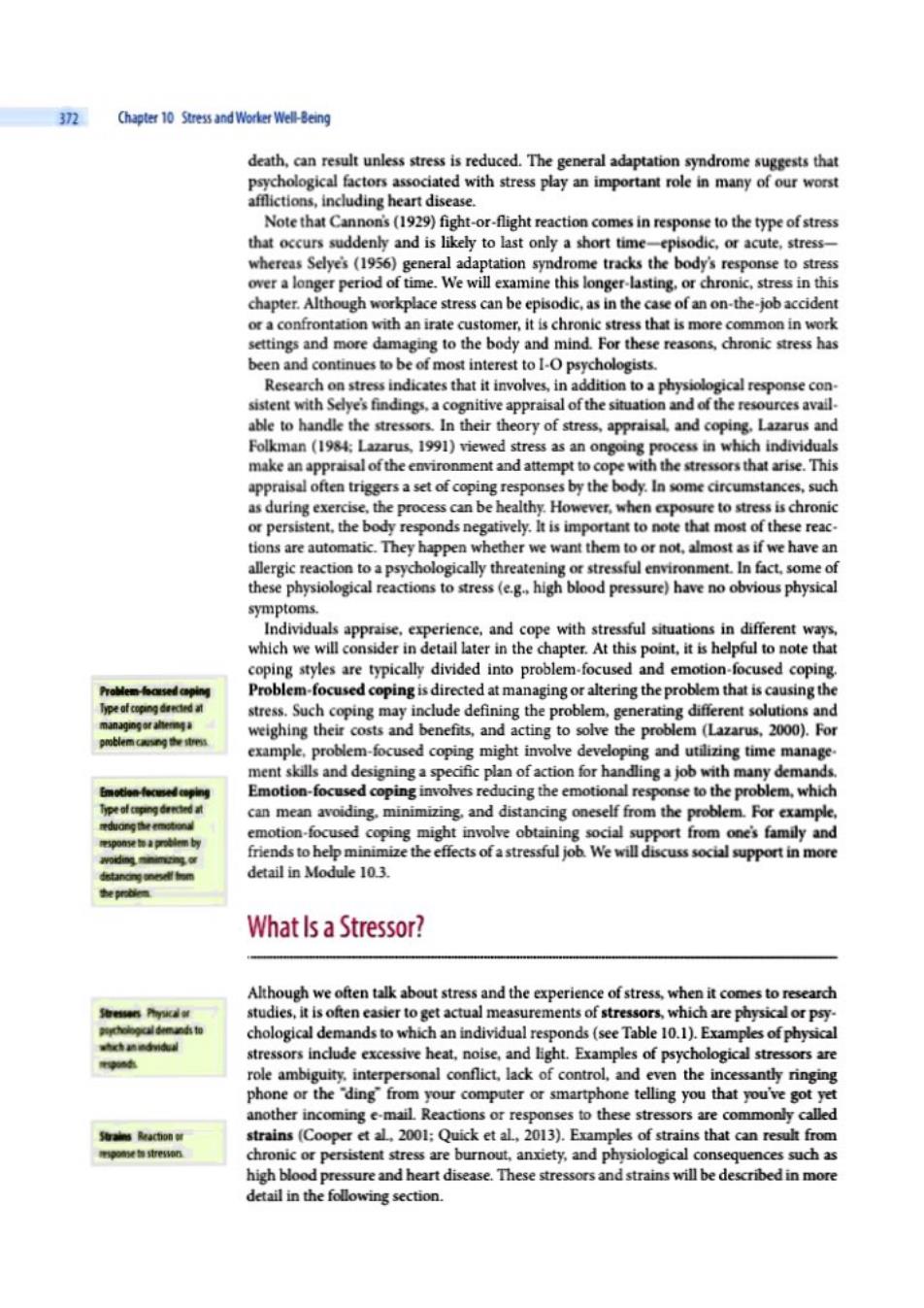
32 Chapter 10 Stress and Worker Well-Being death,can result unless stress is reduced.The general adaptation syndrome suggests that psychological factors associated with stress play an important role in many of our worst afflictions,including heart disease. Note that Cannon's (1929)fight-or-flight reaction comes in response to the type of stress that occurs suddenly and is likely to last only a short time-episodic,or acute,stress- whereas Selye's (1956)general adaptation syndrome tracks the body's response to stress over a longer period of time.We will examine this longer-lasting.or chronic,stress in this chapter.Although workplace stress can be episodic,as in the case of an on-the-job accident or a confrontation with an irate customer,it is chronic stress that is more common in work settings and more damaging to the body and mind.For these reasons,chronic stress has been and continues to be of most interest to I-O psychologists. Research on stress indicates that it involves,in addition to a physiological response con. sistent with Selye's findings.a cognitive appraisal of the situation and of the resources avail. able to handle the stressors.In their theory of stress,appraisal,and coping.Lazarus and Folkman(1984:Lazarus,1991)viewed stress as an ongoing process in which individuals make an appraisal ofthe environment and attempt to cope with the stressors that arise.This appraisal often triggers a set of coping responses by the body.In some circumstances,such as during exercise,the process can be healthy.However,when exposure to stress is chronic or persistent.the body responds negatively.It is important to note that most of these reac- tions are automatic.They happen whether we want them to or not,almost as if we have an allergic reaction to a psychologically threatening or stressful environment.In fact.some of these physiological reactions to stress(e.g..high blood pressure)have no obvious physical symptoms. Individuals appraise,experience,and cope with stressful situations in different ways. which we will consider in detail later in the chapter.At this point,it is helpful to note that coping styles are typically divided into problem-focused and emotion-focused coping. Problem-foorsed copin Problem-focused coping is directed at managing or altering the problem that is causing the lype af coping drectnd at stress.Such coping may include defining the problem,generating different solutions and weighing their costs and benefits,and acting to solve the problem (Lazarus,2000).For example.problem-focused coping might involve developing and utilizing time manage. ment skills and designing a specific plan of action for handling a job with many demands. Emotion-focused coping involves reducing the emotional response to the problem,which can mean avoiding.minimizing.and distancing oneself from the problem.For example, emotion-focused coping might involve obtaining social support from one's family and friends to help minimize the effects of a stressful job We will discuss social support in more detail in Module 10.3. What Is a Stressor? Although we often talk about stress and the experience of stress,when it comes to research studies,it is often easier to get actual measurements of stressors,which are physical or psy- chological demands to which an individual responds(see Table 10.1).Examples of physical stressors include excessive heat,noise,and light.Examples of psychological stressors are role ambiguity.interpersonal conflict,lack of control,and even the incessantly ringing phone or the 'ding"from your computer or smartphone telling you that you've got yet another incoming e-mail Reactions or responses to these stressors are commonly called strains (Cooper et al.2001;Quick et al,2013).Examples of strains that can result from chronic or persistent stress are burnout,anxiety,and physiological consequences such as high blood pressure and heart disease.These stressors and strains will be described in more detail in the following section
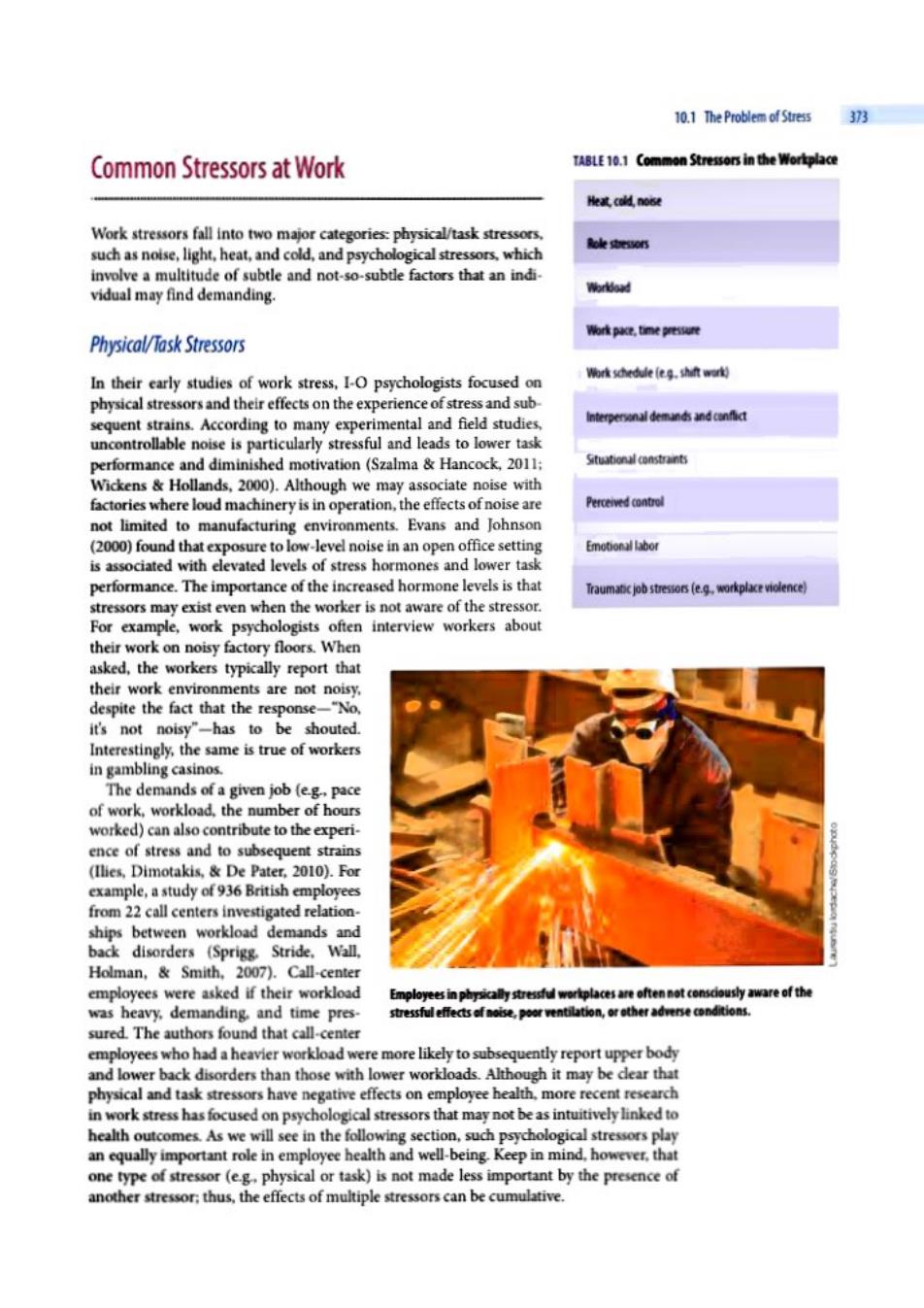
10.1 The Problem of Stress 373 Common Stressors at Work TABLE 10.1 Common Stressors in the Workplace k成cold.no6 Work stressors fall into two major categories:physical/task stressors. Role stessors such as noise,light,heat,and cold,and psychological stressors.which involve a multitude of subtle and not-so-subtle factors that an indi- vidual may find demanding. Woridoad 称hp笔,time pressur Physical/Task Stressors Nork schedule (e.g.hnae由 In their early studies of work stress,I-O psychologists focused on physical stressors and their effects on the experience of stress and sub sequent strains.According to many experimental and field studies, Interpernal demands and canfict uncontrollable noise is particularly stressful and leads to lower task performance and diminished motivation (Szalma Hancock,2011: Situational constraints Wickens Hollands,2000).Although we may associate noise with factories where loud machinery is in operation,the effects of noise are Perceivedcontrol not limited to manufacturing environments.Evans and Johnson (2000)found that exposure to low-level noise in an open office setting Emotional labor is associated with elevated levels of stress hormones and lower task performance.The importance of the increased hormone levels is that Traumatic job stressors (e.g workplaceviolence) stressors may exist even when the worker is not aware of the stressor. For example,work psychologists often interview workers about their work on noisy factory floors.When asked,the workers typically report that their work environments are not noisy. despite the fact that the response-"No. it's not noisy"-has to be shouted. Interestingly,the same is true of workers in gambling casinos. The demands of a given job (eg.pace of work,workload,the number of hours worked)can also contribute to the experi- ence of stress and to subsequent strains (Ilies,Dimotakis,De Pater.2010).For example,a study of 936 British employees from 22 call centers investigated relation- ships between workload demands and back disorders (Sprigg.Stride.Wall, Holman,Smith,2007).Call-center employees were asked if their workload Employees in physically stressful workplaces are often not conscously aware of the was heavy,demanding.and time pres. stressful effects of oise,poor ventilation,orther adverse conditions. sured.The authors found that call-center employees who had a heavier workload were more likely to subsequently report upper body and lower back disorders than those with lower workloads.Although it may be dear that physical and task stressors have negative effects on employee health.more recent research in work stress has focused on psychological stressors that may not be as intuitively linked to health outcomes.As we will see in the following section,such psychological stressors play an equally important role in employee health and well-being.Keep in mind,however,that one type of stressor(eg.physical or task)is not made less important by the presence of another stressor;thus,the effects of multiple stressors can be cumulative

374 Chapter 10 Stress and Worker Well-Being Psychological Stressors Lack of Control/Predictability Control is a major theme in the literature on stress (Ganster Murphy,2000).Varying levels of personal control and predictability have clear effects on job performance and work stress (Logan Ganster.2005).As with any stressor,the individual's perception of control or predictability determines his or her response to the situation,and such percep- tions are affected by characteristics of the job and work environment.The scheduling and pace of work can influence feelings of control.For example,flexible time schedules enhance feelings of control over one's schedule.even though the average arrival and depar. ture times may differ only by minutes after a flexible time schedule has been introduced (Baltes,Briggs,Huff,Wright,Neuman.1999:Totterdell,2005).Flextime also increases perceptions of control by helping employees to balance work and family commitments (Golden,Veiga,Simsek.2006).Perceptions of control in the workplace are also related to autonomy,the extent to which employees can control how and when they perform the tasks of their job(Hackman Oldham.1980).Overall,interventions that enhance per- ceptions of control on the job,such as participative decision making or flexible time schedules,are likely to reduce stress and subsequent strains.In Module 102,we further discuss the importance of control,which is a major component of the demand-control model of stress developed by Karasek(1979). Interpersonal Conflict Negative interactions with co-workers,supervisors,or clients-or interpersonal conflict- egative interactons with can range from heated arguments to subtle incidents of unfriendly behavior (Bruk-Lee tpwn.0 Spector,2006;Jex Britt,2014).Interpersonal conflict can occur when resources at work ient,which can a学om heated ar学ments包te are scarce (e.g,who gets to use the color copy machine first),when employees have incom- ncidents sfunfnen小 patible interests (e.g.one member of a team is a stickler for detail,whereas another likes to complete the project as quickly as possible).or when employees feel they are not being treated fairly (eg.bosses get big bonuses,but workers are told no funds are available for salary increases for the rest of the workforce).Interpersonal conflict can distract workers from important job tasks,and it can have physical health consequences.In a longitudinal study of more than 15,000 Finnish employees,the link between interpersonal conflict at work and subsequent health problems was significant-even when social class,marital sta- Rele stressers Collective tus,conflict with spouse.and high alcohol consumption were taken into account(Romanov, term for stessorsesn Appelberg.Honkasalo,Koskenvuo,1996).Other negative work outcomes of interper- om the multiple tak quirements o时roies af sonal conflict range from depression and job dissatisfaction to aggression,theft,and sabo- aployte tage (Frone,2000a).Interpersonal conflict may also play a part in workplace violence, which we discuss in Module 10.4. Role Theepectatons ardng the responsbilities and requimments ofa Role Stressors ira红地 k的sso Role ambiguity.role conflict,and role overload are collectively referred to as role stressors. aoc when employees The concept ofrole stressors is based on the idea that most jobs have multiple task require. lck dear lnowledge of ments and responsibilities,or roles (Rizzo,House,Lirtzman,1970),and that a job is Ad流or sexpected likely to be particularly stressful if these roles conflict with one another or are unclear.Role ambiguity occurs when employees lack clear knowledge of what behavior is expected in their job.In such cases,individuals experience uncertainty about which actions they nm mands from should take to perform their job most effectively.Role conflict occurs when demands from different sources are incompatible.Students are well aware of this form of conflict. particularly toward the end of the term when they complain.I have four papers due and
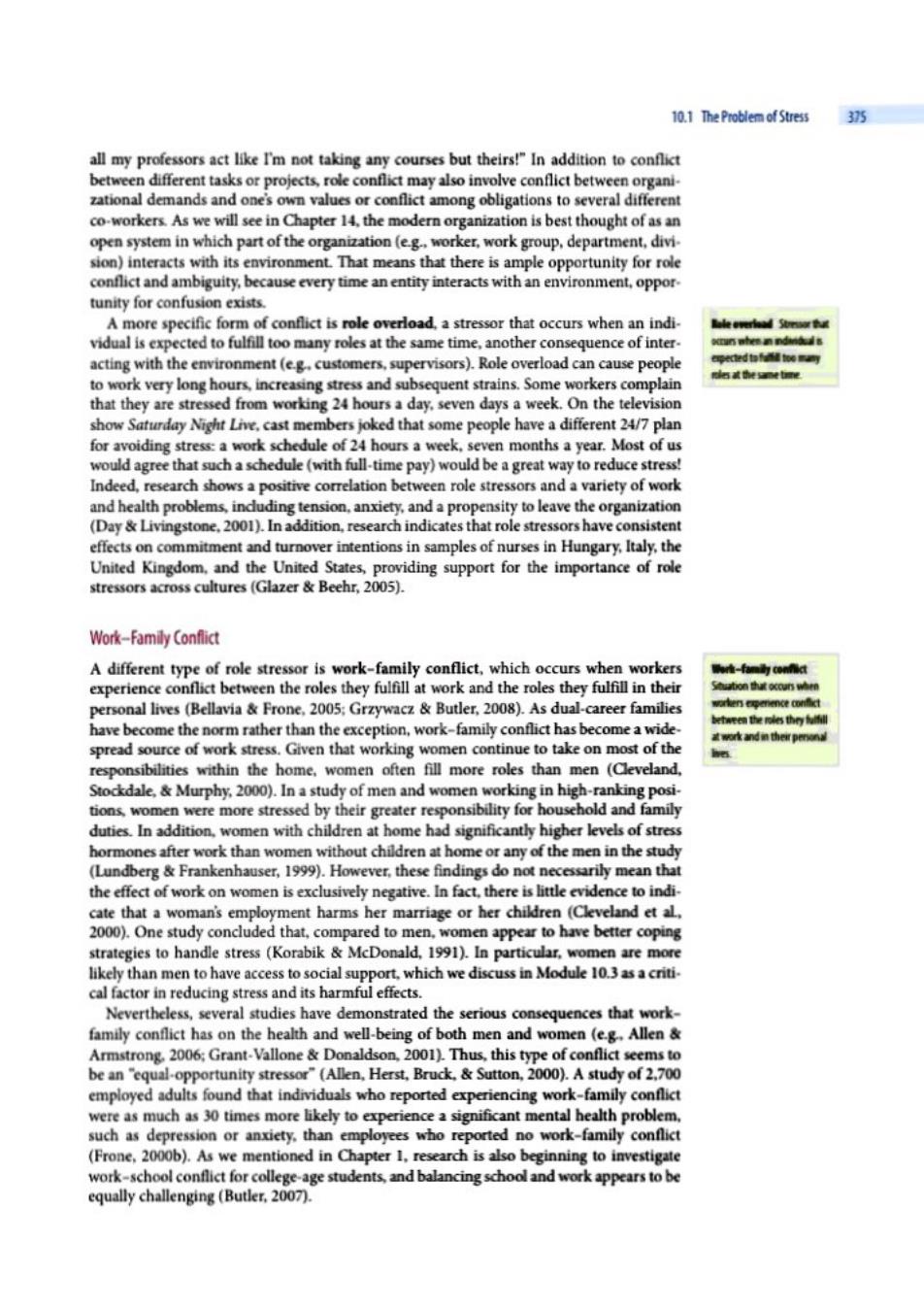
10.1 The Problem of Stress 35 all my professors act like I'm not taking any courses but theirs!"In addition to conflict between different tasks or projects,role conflict may also involve conflict between organi- zational demands and one's own values or conflict among obligations to several different co-workers.As we will see in Chapter 14.the modern organization is best thought of as an open system in which part of the organization (eg.worker,work group,department,divi- sion)interacts with its environment.That means that there is ample opportunity for role conflict and ambiguity,because every time an entity interacts with an environment,oppor. tunity for confusion exists. A more specific form of conflict is role overload,a stressor that occurs when an indi- vidual is expected to fulfill too many roles at the same time,another consequence of inter- acting with the environment (eg.customers,supervisors).Role overload can cause people to work very long hours,increasing stress and subsequent strains.Some workers complain that they are stressed from working 24 hours a day.seven days a week.On the television show Saturday Night Live.cast members joked that some people have a different 24/7 plan for avoiding stress:a work schedule of 24 hours a week.seven months a year.Most of us would agree that such a schedule(with full-time pay)would be a great way to reduce stress! Indeed,research shows a positive correlation between role stressors and a variety of work and health problems,induding tension,anxiety,and a propensity to leave the organization (Day Livingstone,2001).In addition,research indicates that role stressors have consistent effects on commitment and turnover intentions in samples of nurses in Hungary,Italy,the United Kingdom,and the United States,providing support for the importance of role stressors across cultures(Glazer Beehr,2005). Work-Family Conflict A different type of role stressor is work-family conflict,which occurs when workers experience conflict between the roles they fulfill at work and the roles they fulfill in their personal lives (Bellavia Frone,2005:Grzywacz Butler,2008).As dual-career families etween the roles th何轴 have become the norm rather than the exception,work-family conflict has become a wide- 蓝ork and in their penenal spread source of work stress.Given that working women continue to take on most of the responsibilities within the home.women often fill more roles than men (Cleveland. Stockdale,Murphy,2000).In a study of men and women working in high-ranking posi- tions,women were more stressed by their greater responsibility for household and family duties.In addition.women with children at home had significantly higher levels of stress hormones after work than women without children at home or any of the men in the study (Lundberg Frankenhauser,1999).However,these findings do not necessarily mean that the effect of work on women is exclusively negative.In fact,there is little evidence to indi- cate that a woman's employment harms her marriage or her children (Cleveland et al, 2000).One study concluded that,compared to men.women appear to have better coping strategies to handle stress(Korabik McDonald,1991).In particular,women are more likely than men to have access to social support.which we discuss in Module 10.3 as a criti- cal factor in reducing stress and its harmful effects. Nevertheless,several studies have demonstrated the serious consequences that work- family conflict has on the health and well-being of both men and women (eg.Allen Armstrong.2006;Grant-Vallone Donaldson,2001).Thus,this type of conflict seems to be an equal-opportunity stressor"(Allen,Herst,Bruck.Sutton,2000).A study of 2.700 employed adults found that individuals who reported experiencing work-family conflict were as much as 30 times more likely to experience a significant mental health problem. such as depression or anxiety.than employees who reported no work-family conflict (Frone,2000b).As we mentioned in Chapter 1.research is also beginning to investigate work-school conflict for college-age students,and balancing school and work appears to be equally challenging(Butler,2007)

376 Chapter 10 Stressand Worker We-Beng Grzywacz and colleagues (2007)noted that work-family conflict research has focused almost exdusively on profes. sional,white adults.They examined work-family conflict in an immigrant Latino sample employed in the poultry- processing industry.Results indicated that immigrant Latinos experienced infre. quent work-family conflict,and there was little evidence that work-family conflict was associated with health in this sample. They noted that the results demonstrate how traditional models of work-family conflict need to be modified to reflect the needs and circumstances of diverse work- ers in the new global economy"(p.1119). Service ecupations often involve to heep customers happy. Flexible time schedules and child care are becoming increasingly important to working men and women in many different careers.For example,although one might not think that child care would be important to professional athletes,it is provided to members of several sports organizations,indluding professional race car drivers (NASCAR)and the men's and women's professional golf associations.Players in the Ladies'Professional Golf Association reported that the child-care program reduces their concerns about balancing work and family,thereby letting them concentrate on their work (Stewart.2002). Unfortunately,the average working parent is more likely than these athletes to experience work-family stress related to the lack of good child care.A 2001 study by the human resources firm Hewitt Associates found that only 10 percent of U.S.companies offered on-site or off-site child care and another 10 percent arranged for employee discounts at local child-care providers(Finnigan,2001).Thus,80 percent of the workers polled were on their own in terms of child care.It is reasonable to assume that a majority of them experi- enced work-family conflict at some time.The precipitating event is often an unexpected one.such as an illness or injury that prevents a child from attending school or day care. When that happens in a dual-income family.husband and wife are prone to experience a good deal of tension at the breakfast table as they decide who will stay home that day and assume the caregiver role.Notably,the policies of some organizations include illness of a child as an acceptable reason for a parent to take a sick day,whereas others do not. Emotional Labor Interest in the role of emotions in the workplace has increased rapidly over the past two decades.Emotions are important to consider because stress is,first and foremost,an emo- tional reaction.Emotional labor is the regulation of one's emotions to meet job or organi- zational demands(Grandey,Diefendorff,Rupp.2013).Emotional labor has been studied in many different occupations,induding police officers,waiters and waitresses,bill collec. and can be achieve uhwh装ing tors,salesclerks,bank tellers,and flight attendants.The study of emotional labor addresses the stress of managing emotions when jobs require that workers display only certain expres sions to clients or customers (Adelmann.1995).Workers can regulate their emotions Surface acting Emotional through surface acting and deep acting (Morris Feldman,1996).Surface acting consists Labor that consistsaf of managing or faking one's expressions or emotions.For example,waiters in fine restau- 4n4g傅rfaking ane3 rants report that they commonly display pleasant emotions while simultaneously hiding feelings of anger and frustration toward rude customers.Similarly.bill collectors are encour. aged to ignore their feelings of irritation and hostility toward uncooperative debtors and

10.1 TheProblem of Stress 37 instead to display neutrality or calmness-the emotions that their employers have found lead to a greater likelihood that debtors will pay their bills(Sutton.1991).Deep acting con sists of managing one's feelings,incuding trying to actually change one's emotional state to match the emotions required by the job.For example.a waitress might try to imagine her. self in a difficult customer's situation to try to feel empathy for the customer and better understand the customer's point of view.Because deep acting involves modifying one's emotions and feelings,it results in expressions that are more authentic,more effective,and more associated with positive health outcomes than surface acting does(Chi.Grandey. Diamond,Krimmel,2011).This finding supports the notion that authenticity is impor. tant in the workplace.Chi and colleagues (2011)also found that surface acting can be a successful strategy for extraverts but not for introverts.They conduded by givinga tip for service providers:Only extraverts should fake their surface-level expressions,but introverts can do as well as extraverts if they regulate their deeper feelings"(p.1344). Grandey.Kern,and Frone (2007)found that workers in jobs requiring emotional labor often encounter verbal abuse from customers,which can include insults,swearing.and yell. ing.In one study.U.S.call-center employees reported an average of seven hostile calls a day (Grandey,Dickter,Sin.2004):in another study.75 percent of U.K.airline and railway employees reported that they were verbally abused at least once a month (Boyd,2002).We can speculate that some of these abusive customers come to the situation already emotion. ally primed for a confrontation,either because they are frustrated with the employee's organization (e.g.,they tried unsuccessfully to book tickets from a website)or because of unrelated stress (e.g..a romantic breakup). Stress and discomfort are likely to occur when the required emotions differ from employ. ees'actual emotions.Suppressing emotions or showing false emotions requires cognitive and physiological effort,which is likely to be stressful over the long term.Research indicates that the stress of emotional labor can lead to job dissatisfaction,burnout,and turnover intentions (Grandey,2003;Pugh,Groth,Hennig-Thurau.2011).To reduce the stress of emotional labor,I-0 psychologists recommend that employees use humor,obtain social support from co-workers,and depersonalize the encounter with customers or clients.Rupp and Spencer (2006)suggested that organizations might train employees to regulate their emotions(i.e.. engage in deep acting)when dealing with difficult customers.In addition.a study that included samples from the United States and France found that when employees believed that they had control over their jobs,emotional labor that would otherwise be exhausting was not exhausting at all (Grandey.Fisk.Steiner,2005).The results suggested that if"man. agers in the U.S.and France were to enhance employees'perceptions of job autonomy,the reduction in burnout would be notable"(p.902).Allen.Diefendorff,and Ma (2014)exam. ined differences in emotional labor in Chinese and U.S.service workers.They found that the commonly identified sequence of required display rules to surface acting to burnout was evident in the U.S.sample but not in the Chinese sample.They concluded that the findings on emotional labor that have been identified with Western samples may not apply in other cultures.Additional consideration ofemotional labor in different cultural contexts is needed. particularly as the service sector continues to grow in many countries and more employees Challenge-re山ted are required to provide "service with a smile"(Kim Yoon.2012:Pugh.2001). Recent research has begun to differentiate between challenge-related and hindrance. related stressors.Challenge-related stressors are defined as work demands or circum- stances that,although potentially stressful,offer potential gains(Boswell,Olson-Buchanan, LePine,2004).Examples of challenge-related stressors are the number of projects assigned,time spent at work,volume of work in a given time,and the amount and scope of responsibilities.Hindrance-related stressors are defined as job demands or circumstances that tend to limit or interfere with work achievement.Examples ofhindrance-related stress- ors include the degree to which politics rather than performance affects organizational decisions,administrative red tape,lack of job security.stalled career progression,and even
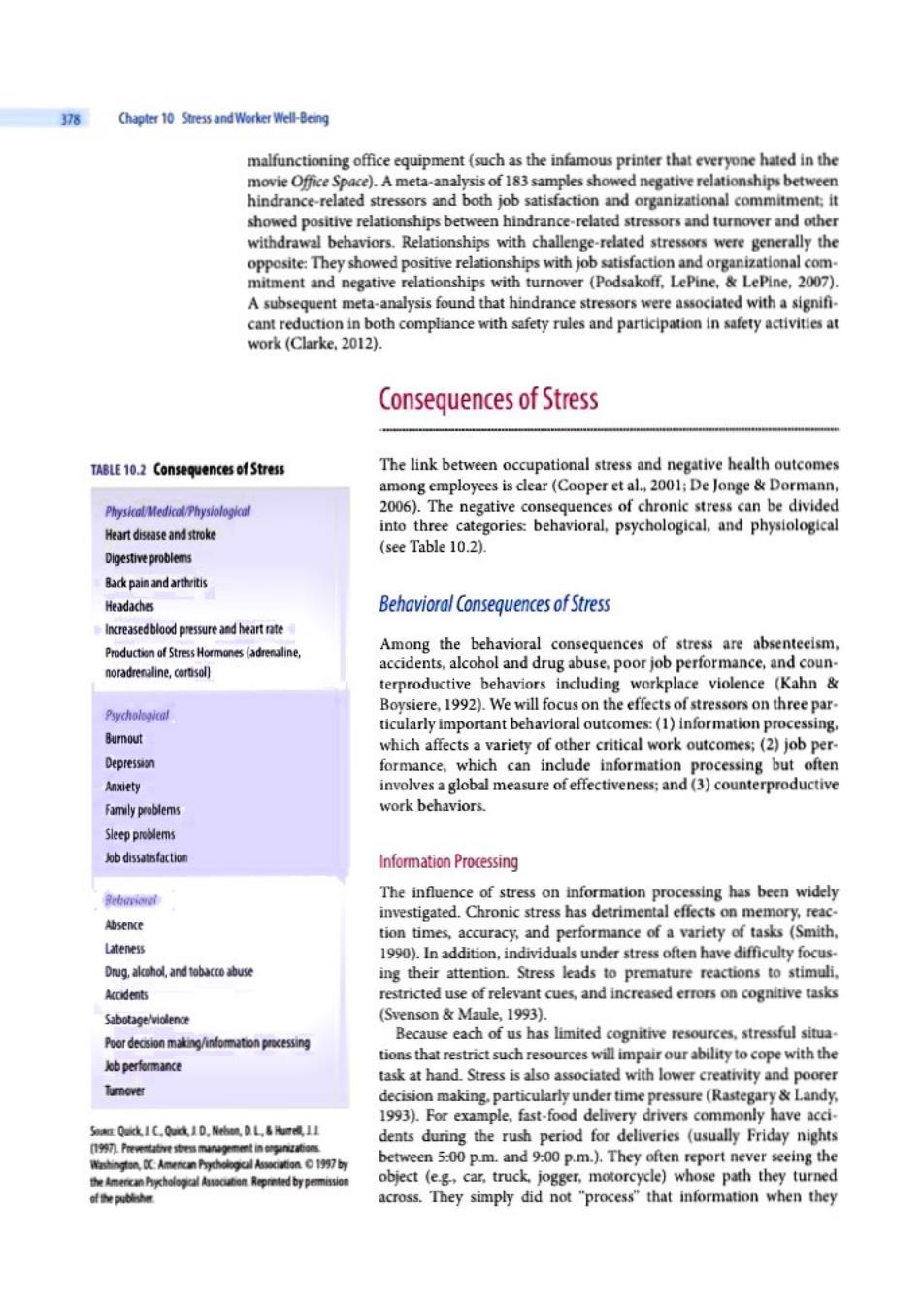
378 Chapter 10 Stress andWorker Well-Being malfunctioning office equipment (such as the infamous printer that everyone hated in the movie Office Space).A meta-analysis of 183 samples showed negative relationships between hindrance-related stressors and both job satisfaction and organizational commitment:it showed positive relationships between hindrance-related stressors and turnover and other withdrawal behaviors.Relationships with challenge-related stressors were generally the opposite:They showed positive relationships with job satisfaction and organizational com. mitment and negative relationships with turnover(Podsakoff,LePine,LePine,2007). A subsequent meta-analysis found that hindrance stressors were associated with a signifi- cant reduction in both compliance with safety rules and participation in safety activities at work(Clarke,2012). Consequences of Stress TABLE 10.2 Consequences of Stress The link between occupational stress and negative health outcomes among employees is clear (Cooper et al.,2001;De Jonge Dormann, Physical/Medical/Physiological 2006).The negative consequences of chronic stress can be divided Heart disease and stroke into three categories:behavioral,psychological,and physiological (see Table 10.2). Digestiveproblems Back pain and arthritis Headaches Behavioral Consequences of Stress Increased blood pressure and heart rate Productnof Stress Hormones (adreie, Among the behavioral consequences of stress are absenteeism, noradrenaline,comsol) accidents,alcohol and drug abuse,poor job performance,and coun- terproductive behaviors including workplace violence (Kahn& Boysiere,1992).We will focus on the effects of stressors on three par. Psycholegicnl ticularly important behavioral outcomes:(1)information processing. Burout which affects a variety of other critical work outcomes;(2)job per- Depression formance,which can include information processing but often Anxiety involves a global measure of effectiveness;and(3)counterproductive Famly problems work behaviors. Sleep problems lob dissatisfaction Information Processing Beboviongl The influence of stress on information processing has been widely investigated.Chronic stress has detrimental effects on memory,reac- Absence tion times,accuracy,and performance of a variety of tasks (Smith, Lateness 1990).In addition,individuals under stress often have difficulty focus. Drug.alchol,and tobacoabuse ing their attention.Stress leads to premature reactions to stimuli. Acodents restricted use of relevant cues,and increased errors on cognitive tasks Sabotageviolence (Svenson Maule,1993). Poor decsion making/infommation processing Because each of us has limited cognitive resources,stressful situa- tions that restrict such resources will impair our ability to cope with the lb performance task at hand.Stress is also associated with lower creativity and poorer Tumover decision making.particularly under time pressure(Rastegary Landy, 1993).For example,fast-food delivery drivers commonly have acci. Sear:Quick IC.Quck J D.Nebon.D L.Humed 1I dents during the rush period for deliveries(usually Friday nights 初.e地tsn4 nagemmnt情学n应a酒 WashingtonC:Amencan Pychologcal Association1997 by between 5:00 p.m.and 9:00 p.m.).They often report never seeing the object (eg,car,truck.jogger,motorcycle)whose path they turned of the publinher across.They simply did not "process"that information when they